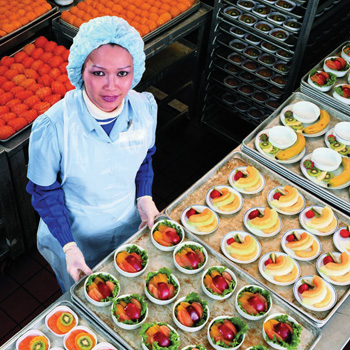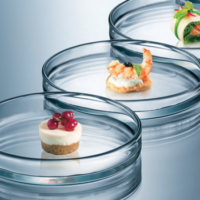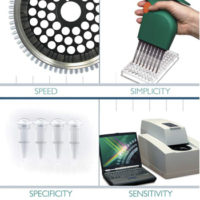Key Steps to a Total Listeria Testing Solution

In a continuing effort to improve food safety programs and protect the general public against foodborne illness, the U.S. Department of Agriculture’s Food Safety and Inspection Service (USDA FSIS) issued a final ruling on control of Listeria monocytogenes in ready-to-eat (RTE) foods and poultry in December 2004. A ready-to-eat product is adulterated if it contains L. monocytogenes or if it comes into direct contact with a food contact surface that is contaminated with L. monocytogenes. According to the Centers for Disease Control and Prevention (CDC), the rate of listeriosis has fallen by 35% from 1996-2002; however, each year, L. monocytogenes still causes an estimated 2,493 cases of foodborne listeriosis and 499 deaths.
To prevent occurrence of listeriosis, regulators recommend the total absence of Listeria species in the food environment, as presence of the organism is indicative of insufficient hygiene practices in the handling of raw materials and finished products. Routine testing of high-risk products that may support the growth of Listeria is critical, both for the prevention of illness and to avoid costly recalls within the food industry.
Food companies have responded by implementing changes in their testing programs and increasing the volumes of environmental tests performed, which presents a number of challenges. While companies want to ensure that their test methods are effective, they must also meet corporate goals to improve efficiencies and reduce costs associated with testing. To achieve this, many companies are using a “total testing solution,” such as those offered by Strategic Diagnostics Inc. (SDI), a leading manufacturer of immunoassay based test kits for field testing and laboratory use and makers of RapidChek screening systems for foodborne pathogens, including Listeria (www.sdix.com).
A total solution includes enrichment, assay and confirmation of result, and offers real world advantages, including labor savings, storage, training and a reduction of total cost in use, says Dr. Orla Cloak, SDI senior research scientist and product manager. “As regulations increase and consumer demands for quality grow, it is important to find a total testing solution that fits with the customer’s needs.”
Top 5 Factors in Choosing a Listeria Test Method
The RapidChek Listeria species test for RTE foods and environmental samples, which gained AOAC International approval in June 2004, is a good example. RapidChek Listeria is the next-generation immunoassay, offering the high quality and performance of a polymerase chain reaction (PCR) based assay with the ease-of-use of a lateral flow device. “It is a common perception in the marketplace that lateral flow devices are easy to use but are inferior in quality to PCR based methods, but this is not true,” Cloak says. “Technology advances in enrichment systems and lateral flow optimization means these systems are as sensitive and specific as a nucleic acid based systems. Food companies do not need to compromise on Listeria testing. They can have both ease-of-use and cutting-edge technology, improve training efficiencies and reduce the total cost of use with an AOAC-validated lateral flow based method.”
She suggests several key factors to consider when selecting a total testing solution-oriented system for Listeria. These include:
1. Enrichment System. Listeria has a longer lag phase and growth rate relative to many other foodborne pathogens, and the organism may be injured in the food but still capable of causing illness. It is important that the enrichment component of the testing system facilitate sufficient recovery of all Listeria present. This is vital, not only in the recovery of the target but in the overall sensitivity and specificity of a testing system. An enrichment that supports rapid growth of Listeria while suppressing other bacteria present will reduce total time to result and increase the sensitivity of the detection system.
2. Accuracy. False positives incur unnecessary costs related to further confirmation, while false negatives run the risk of testing system failure, which can result in product recall, brand defamation and damage to the company’s reputation in the marketplace. It is important that a testing system detect all Listeria species present, have a low false positive/negative rate and have a minimal detection limit of 1 cell per 25 g of sample.
3. Validation. Most methods on the market have AOAC validation, which is viewed as a necessity for acceptability. This shows the method has been evaluated, challenged and peer reviewed, meeting or exceeding reference method standards.
4. Training. A simple method that provides accurate and reliable results can alleviate the need for excessive training, and the costs and time associated with it. If the testing method has few steps and is easy to interpret it reduces the chance of user error—and builds confidence in the end result. More complex technology methods require more training, and frequent turnover of laboratory personnel means management spends a lot of time and money training new staff.
5. Economics. The total cost of a testing system is an important aspect in the evaluation of any test. Testing is an expensive process. The often hidden cost factors include the steps involved in the method, media preparation, transfers, run time and time to read result.
“Choosing the right Listeria test method,” Cloak says, “not only helps companies reap the benefits of cost savings and efficiencies offered by a total testing solution, but also enhances the success of the company’s overall food safety and quality assurance goals.”
www.sdix.com
Looking for a reprint of this article?
From high-res PDFs to custom plaques, order your copy today!





